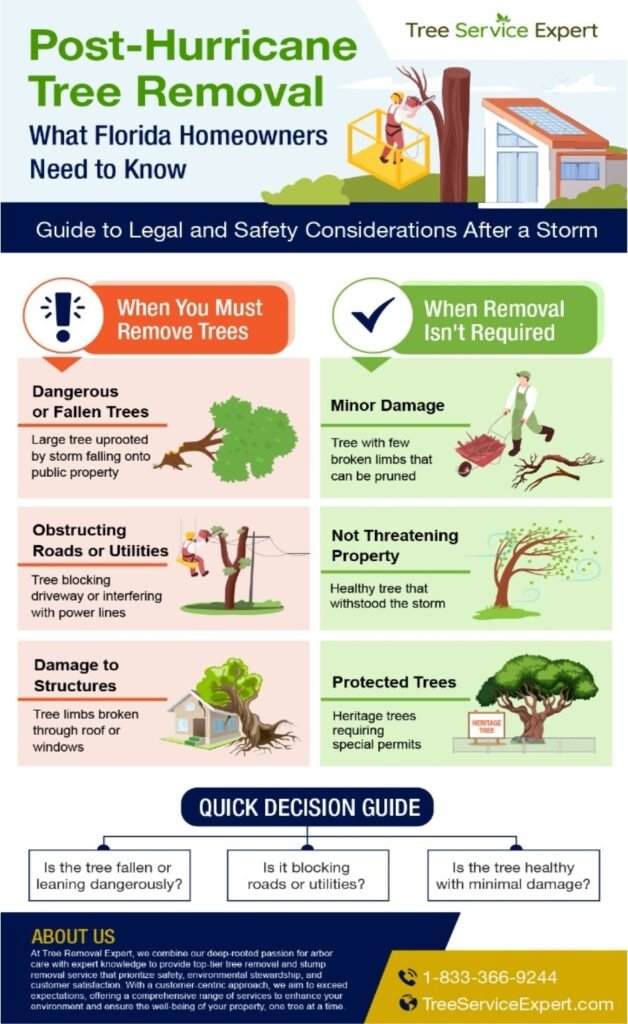Hurricanes can leave Florida homeowners facing significant expenses for tree removal and property repairs. Tree Service Expert understands the financial challenges of post-storm recovery. This guide outlines ten cost-effective practices for managing trees after hurricanes, helping you balance safety, property value, and budget concerns.
1. Conduct a Cost-Benefit Analysis
Before taking action, assess the economic impact of each tree:
- Evaluate the tree’s contribution to property value
- Consider energy savings from shade
- Weigh removal costs against potential future damage
2. Prioritize High-Risk, High-Value Areas
Focus resources where they matter most:
- Address trees threatening structures or utilities first
- Prioritize trees in high-traffic areas
- Delay non-essential work to spread costs over time
3. Explore Insurance Coverage Options
Maximize your insurance benefits:
- Review your policy for tree damage coverage
- Document all damage thoroughly with photos and videos
- Consult with Tree Service Expert for professional damage assessments to support claims
4. Consider Tree Preservation Over Removal
Saving trees can be more cost-effective long-term:
- Evaluate the cost of treatment versus removal and replacement
- Consider the time and expense of growing new trees to maturity
- Assess the impact on property value and energy costs
5. Utilize Municipal and Community Resources
Take advantage of available assistance:
- Check for city programs that help with storm debris removal
- Organize neighborhood clean-up efforts to share costs
- Explore grants or low-interest loans for major tree work
6. Implement Preventive Measures
Invest in prevention to reduce future costs:
- Regular pruning to remove weak branches
- Install bracing or cabling for vulnerable trees
- Plant wind-resistant species to reduce long-term expenses
7. Time Your Tree Work Strategically
Plan tree work to maximize cost-effectiveness:
- Schedule non-emergency work during off-peak seasons for better rates
- Combine multiple tree services to potentially reduce overall costs
- Consider multi-year contracts with Tree Service Expert for ongoing maintenance
8. Repurpose Tree Debris
Find value in fallen trees and branches:
- Convert suitable wood to firewood or mulch
- Sell or donate high-quality lumber to offset removal costs
- Use tree debris for landscaping features or erosion control
9. Invest in Professional Assessments
Avoid costly mistakes with expert guidance:
- Hire certified arborists for accurate health and risk assessments
- Get multiple quotes for major tree work
- Use professional advice to make informed, cost-effective decisions
10. Plan for Long-Term Value
Make decisions that offer long-term economic benefits:
- Choose tree species that are low-maintenance and storm-resistant
- Invest in proper planting and early care for healthier, more valuable trees
- Develop a long-term tree management plan to reduce future emergency costs
FAQs
Q: How much does it typically cost to remove a large tree after a hurricane? A: Costs can vary widely, from $500 to $5,000 or more, depending on the tree’s size, location, and condition. Tree Service Expert offers free estimates for accurate pricing.
Q: Can I deduct the cost of tree removal on my taxes? A: In some cases, yes. If the tree removal is due to a federally declared disaster, it may be tax-deductible. Consult with a tax professional for specific advice.
Q: Is it more cost-effective to handle small tree jobs myself? A: While DIY can save money on small jobs, it’s important to consider safety risks and potential property damage. Professional services often provide better long-term value.
Conclusion
Managing trees after a hurricane requires balancing immediate safety concerns with long-term economic considerations. By implementing these cost-effective practices, you can recover from storm damage while protecting your property value and financial well-being.
For expert assistance in developing a cost-effective tree management strategy, contact Tree Service Expert. Our team of professionals can help you make informed decisions that maximize the value of your trees while minimizing long-term expenses.
